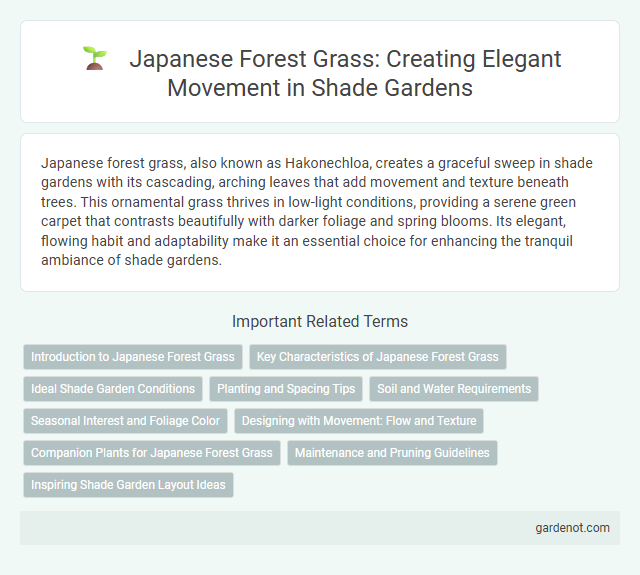Japanese forest grass, also known as Hakonechloa, creates a graceful sweep in shade gardens with its cascading, arching leaves that add movement and texture beneath trees. This ornamental grass thrives in low-light conditions, providing a serene green carpet that contrasts beautifully with darker foliage and spring blooms. Its elegant, flowing habit and adaptability make it an essential choice for enhancing the tranquil ambiance of shade gardens.
Introduction to Japanese Forest Grass
Japanese forest grass (Hakonechloa macra) is a shade-tolerant ornamental grass prized for its graceful, arching foliage and vibrant green to golden-yellow hues. Native to Japan, it thrives in moist, well-drained soil and adds texture and movement to shaded garden areas. Its low maintenance and adaptability make it ideal for woodland gardens, borders, and ground cover in low-light environments.
Key Characteristics of Japanese Forest Grass
Japanese Forest Grass (Hakonechloa macra) features gracefully arching, bamboo-like leaves that display vibrant shades of green and gold, creating a soft, flowing texture ideal for shady garden spots. Its compact, clumping growth habit reaches 12 to 18 inches in height, making it perfect for ground cover or edging in moist, well-drained soils under tree canopies. This shade-loving perennial thrives in partial to full shade, exhibiting excellent drought tolerance and minimal pest issues, which enhances its value in low-light, low-maintenance landscape designs.
Ideal Shade Garden Conditions
Japanese forest grass (Hakonechloa macra) thrives in ideal shade garden conditions characterized by partial to full shade with dappled sunlight. It prefers well-drained, humus-rich soil with consistent moisture to support its vibrant foliage and graceful arching habit. This ornamental grass enhances shade gardens by providing soft texture and year-round interest in USDA zones 5-9.
Planting and Spacing Tips
Japanese forest grass (Hakonechloa macra) thrives in shaded garden areas with well-drained, moist soil. When planting, space the clumps about 18 to 24 inches apart to allow for natural spreading and airflow. Proper spacing prevents overcrowding and encourages healthy growth, maintaining the grass's delicate, cascading appearance.
Soil and Water Requirements
Japanese forest grass (Hakonechloa macra) thrives in well-drained, humus-rich soil with consistent moisture to maintain its vibrant foliage and graceful sweep. It prefers slightly acidic to neutral pH levels, optimizing nutrient uptake in shaded garden environments. Regular watering is essential, especially during dry spells, to prevent leaf scorch and preserve its lush, arching habit.
Seasonal Interest and Foliage Color
Japanese forest grass (Hakonechloa macra) offers exceptional seasonal interest with its vibrant foliage that shifts from bright green in spring and summer to stunning golden-yellow and copper hues in fall. Its graceful, arching leaves create dynamic texture and movement in shaded garden areas. This ornamental grass maintains color intensity well into the cooler months, enhancing year-round visual appeal in shade gardens.
Designing with Movement: Flow and Texture
Japanese forest grass (Hakonechloa macra) creates dynamic movement in shade garden designs through its cascading, arching blades that sway gracefully with the breeze. Its fine-textured foliage introduces a soft, flowing rhythm that contrasts beautifully with coarser plants, enhancing visual depth and texture. Incorporating this ornamental grass strategically ensures continuous motion, adding a serene and naturalistic feel to shaded landscapes.
Companion Plants for Japanese Forest Grass
Japanese Forest Grass (Hakonechloa macra) thrives when paired with hostas, ferns, and astilbes, which complement its graceful, arching foliage in shade gardens. Companion plants like hellebores and heucheras offer contrasting textures and colors, enhancing the visual appeal of shaded areas. These plant combinations improve soil moisture retention and create a layered, naturalistic garden environment ideal for shaded woodland settings.
Maintenance and Pruning Guidelines
Japanese forest grass sweep (Hakonechloa macra) thrives in shaded garden areas with minimal maintenance. Regular removal of dead or damaged foliage in early spring promotes healthy growth and prevents disease. Pruning should focus on trimming back old leaves to the base before new shoots emerge, ensuring a tidy appearance and optimal plant vigor.
Inspiring Shade Garden Layout Ideas
Japanese forest grass (Hakonechloa macra) adds graceful texture and vibrant green hues to shade gardens, making it ideal for tranquil, woodland-inspired layouts. Its cascading foliage complements ferns, hostas, and shade-loving perennials, enhancing layered garden designs that emphasize depth and contrast. Incorporating Japanese forest grass creates a serene, flowing effect that transforms shaded areas into inviting, visually dynamic retreats.
Japanese forest grass sweep Infographic

 gardenot.com
gardenot.com